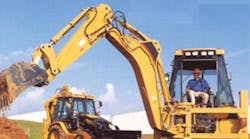Power control (torque limiting) - When sizing a hydraulic pump without power control, the pump's displacement must be based on the corner horsepower - maximum flow at maximum pressure. This corner horsepower should not exceed power available from the engine, otherwise the engine will stall. Not using all the hydraulic power available wastes energy.
To circumvent this limitation, pump controls can be implemented to limit the torque consumed by the pump regardless of its corner horsepower. This is accomplished by limiting the pump's discharge pressure based on its displacement. Therefore, higher flows can be achieved at lower pressures and lower flows at higher pressures, thus preventing the engine from stalling or becoming overloaded.
Another benefit is enhanced machine operation. Higher corner horsepower allows faster working speeds from higher flow rates or higher forces from higher pressures. Also, engine power is applied more effectively, leading to higher fuel economy, lower noise and exhaust emissions, and no engine overloading or stalling.
Dual horsepower control (dual torque limiting) - When a backhoe loader is used as an excavator, nearly all engine power is used for the backhoe's hydraulic implements. But when used as a loader, only a portion of the engine power is used for hydraulic implements. This is because engine power must be shared between the loader's hydraulic implements and the drive transmission.
Dual power control allows shifting between high- and low-pressure operating modes. This is done by utilizing the power control valve's dependency on the control flow rate to modify the power output setting. Increasing control flow to the power control valve raises pressure in the control line and increases the power output setting. Conversely, delivering less flow reduces pressure and, therefore, the power output setting.







